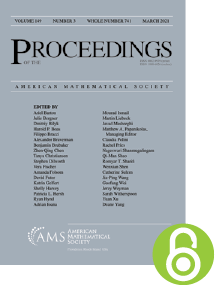Vanishing of the leading term in Harish-Chandra’s local character expansion
HTML articles powered by AMS MathViewer
- by Reid C. Huntsinger PDF
- Proc. Amer. Math. Soc. 124 (1996), 2229-2234 Request permission
Abstract:
Harish-Chandra’s formula for the character $\Theta _\pi$ of an irreducible smooth representation $\pi$ of a reductive $p$-adic group $G$ expresses $\Theta _\pi$ near $1$ as a linear combination of the Fourier transforms of nilpotent $G$-orbits in the Lie algebra of $G$. In this note, we prove that if $\pi$ is tempered but not in the discrete series, then the coefficient attached to the zero nilpotent orbit vanishes.References
- M. Assem, The Fourier transform and some character formulæ for $p$-adic $\text {SL}_\ell$, $\ell$ a prime, Amer. J. Math., to appear.
- Laurent Clozel, Invariant harmonic analysis on the Schwartz space of a reductive $p$-adic group, Harmonic analysis on reductive groups (Brunswick, ME, 1989) Progr. Math., vol. 101, Birkhäuser Boston, Boston, MA, 1991, pp. 101–121. MR 1168480, DOI 10.1007/978-1-4612-0455-8_{6}
- Harish-Chandra, Harmonic analysis on reductive $p$-adic groups, Lecture Notes in Mathematics, Vol. 162, Springer-Verlag, Berlin-New York, 1970. Notes by G. van Dijk. MR 0414797, DOI 10.1007/BFb0061269
- Harish-Chandra, Admissible invariant distributions on reductive $p$-adic groups, Lie theories and their applications (Proc. Ann. Sem. Canad. Math. Congr., Queen’s Univ., Kingston, Ont., 1977) Queen’s Papers in Pure Appl. Math., No. 48, Queen’s Univ., Kingston, Ont., 1978, pp. 281–347. MR 0579175
- —, The Plancherel formula for reductive $p$-adic groups, Collected Works, vol. IV (ed. V.S. Varadarajan), Springer-Verlag, Berlin, Heidelberg and New York, 1984, pp. 353–367.
- Rebecca A. Herb, Elliptic representations for $\textrm {Sp}(2n)$ and $\textrm {SO}(n)$, Pacific J. Math. 161 (1993), no. 2, 347–358. MR 1242203
- Roger Howe, The Fourier transform and germs of characters (case of $\textrm {Gl}_{n}$ over a $p$-adic field), Math. Ann. 208 (1974), 305–322. MR 342645, DOI 10.1007/BF01432155
- David Kazhdan, Cuspidal geometry of $p$-adic groups, J. Analyse Math. 47 (1986), 1–36. MR 874042, DOI 10.1007/BF02792530
- C. Mœglin and J.-L. Waldspurger, Modèles de Whittaker dégénérés pour des groupes $p$-adiques, Math. Z. 196 (1987), no. 3, 427–452 (French). MR 913667, DOI 10.1007/BF01200363
- Fiona Murnaghan, Asymptotic behaviour of supercuspidal characters of $p$-adic $\textrm {GL}_3$ and $\textrm {GL}_4$: the generic unramified case, Pacific J. Math. 148 (1991), no. 1, 107–130. MR 1091533, DOI 10.2140/pjm.1991.148.107
- Fiona Murnaghan, Asymptotic behaviour of supercuspidal characters of $p$-adic $\textrm {GSp}(4)$, Compositio Math. 80 (1991), no. 1, 15–54. MR 1127058
- —, Characters of supercuspidal representations of classical groups, preprint.
- Ranga Rao, Orbital integrals on reductive groups, Ann. of Math. 96 (1972), 505–510.
- Jonathan D. Rogawski, An application of the building to orbital integrals, Compositio Math. 42 (1980/81), no. 3, 417–423. MR 607380
- Paul J. Sally Jr., Some remarks on discrete series characters for reductive $p$-adic groups, Representations of Lie groups, Kyoto, Hiroshima, 1986, Adv. Stud. Pure Math., vol. 14, Academic Press, Boston, MA, 1988, pp. 337–348. MR 1039842, DOI 10.2969/aspm/01410337
- J. A. Shalika, A theorem on semi-simple ${\cal P}$-adic groups, Ann. of Math. (2) 95 (1972), 226–242. MR 323957, DOI 10.2307/1970797
- Marko Tadić, Notes on representations of non-Archimedean $\textrm {SL}(n)$, Pacific J. Math. 152 (1992), no. 2, 375–396. MR 1141803, DOI 10.2140/pjm.1992.152.375
- G. Van Dijk, Computation of certain induced characters of $p$-adic groups, Math. Ann. 199 (1972), 229–240.
Additional Information
- Reid C. Huntsinger
- Email: reid@math.uchicago.edu
- Received by editor(s): September 7, 1994
- Received by editor(s) in revised form: November 8, 1994
- Communicated by: Roe Goodman
- © Copyright 1996 American Mathematical Society
- Journal: Proc. Amer. Math. Soc. 124 (1996), 2229-2234
- MSC (1991): Primary 22E50
- DOI: https://doi.org/10.1090/S0002-9939-96-03183-8
- MathSciNet review: 1307530


